(Written by William)
One of the more recent LEGO themes that captured my attention is LEGO Hidden Side. My favorite set from the theme has been the #70425 LEGO Hidden Side Newbury Haunted High School (see link for review at the end of this post), so I figured that from the most recently released wave the #70437 LEGO Hidden Side Mystery Castle should be similarly great.
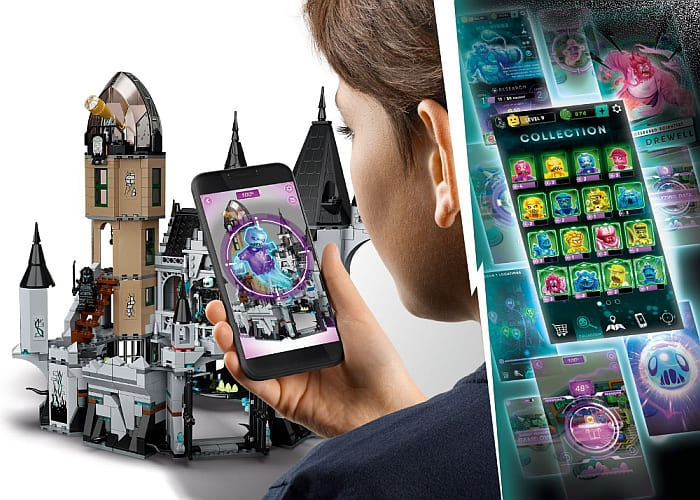
Being a LEGO Castle fan, it was impossible for me not to like the Mystery Castle. Building the set gave me quite a bit nostalgia for building old LEGO castles. There are plenty of large elements to give the Mystery Castle an impressive size, and the newer elements made the design feel updated and fresh. And the minifigures are fantastic, just like in all the other LEGO Hidden Side sets.
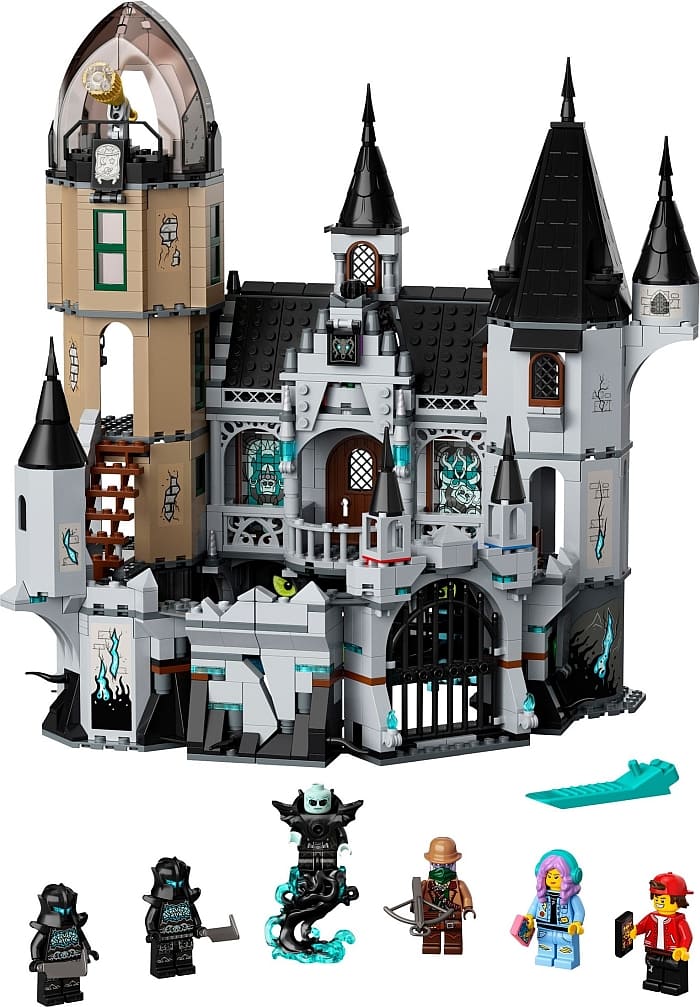
Having said that, I still feel that the High School is a better LEGO Hidden Side set. The Mystery Castle never hides its monstrous side like the High School does. In fact, viewed from above, the big monster feature is not hidden at all. To really get the full impact of the transformation feature, you’re going to have to view the set from the eye level of a minifig. Also, the set comes with 37 stickers on two sticker-sheets, and like it or not, they do add a ton of detail and character to the model. Without them, the castle feels bland. If you don’t like stickers, this set may make you cringe.
So there is some good and bad for the Mystery Castle overall. In the video above, I share some more of my general thoughts and also demonstrate some of the play-features, and the next question is, what can we learn from this set? Turns out, it’s quite a bit. This is one of the reasons I’ve fallen in love with the LEGO Hidden Side theme. Sure, there is the LEGO Hidden Side app that can give you more play options with augmented reality, but I don’t even play with that. It’s the dual nature of normal and haunted versions of the sets that keep me coming back. So now let’s look at a few of the interesting building techniques.
LEGO HIDDEN SIDE CASTLE – TIMING A MECHANISM
The most involved play-feature in the Mystery Castle is a trap door that drops into the monster’s maw. When this occurs, large tentacle appendages close in and the eyes of the giant monster face forward. Normally, these are the types of features we see act independently of one another. But in this set, these action elements are packaged together.
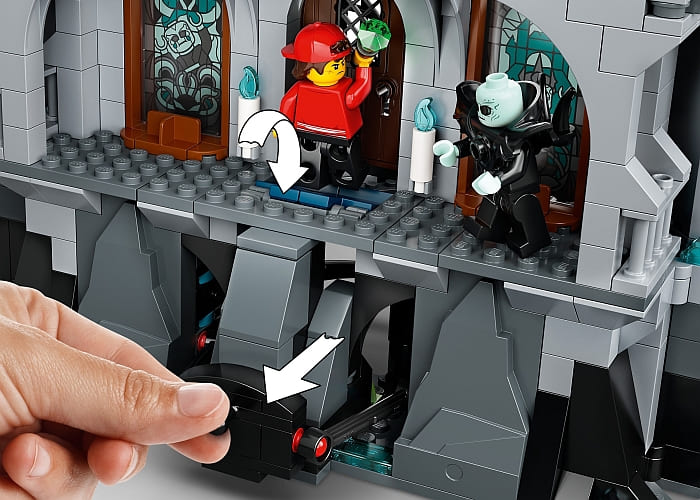
Making this happen is probably the simplest technique I’ve ever talked about in this Brick Breakdown series. Put it simply, each mechanism shares the same trigger. This automatically means they have to work together. Normally, I’d say this is nothing special, after all, the timing of these elements is a no brainer, but this is kind of why I think this is an excellent example.

Take something more complex, like a Great Ball Contraption (GBC) which has nearly countless ways to move a ball around, and they do this by getting different mechanisms to work together. Granted, not every GBC will get their mechanisms to time together by sharing a trigger like in the Mystery Castle, but it is a fundamental step in learning to build one. And learning how to create common ground between differing action elements is sometimes trickier than you might expect.
An interesting way to tackle this type of problem is to imagine how you’d build a trigger that connects to both action elements. This is a much simpler problem to solve rather than asking to create a meaningful transition between moving elements. By doing one, you’re actually doing the other.
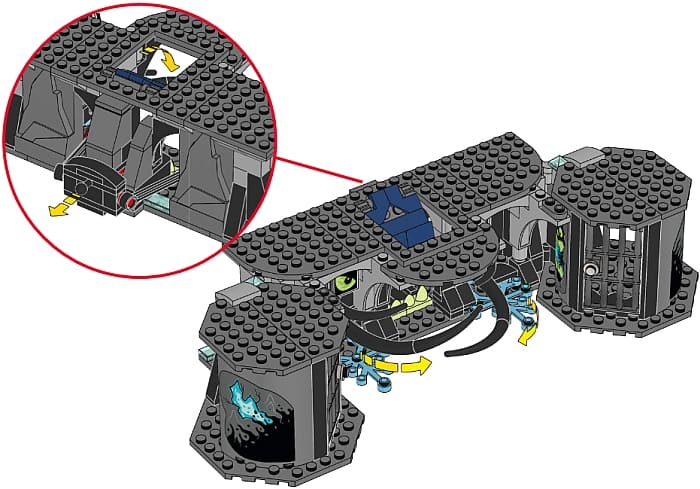
In the Mystery Castle, the tentacles and eyes are using LEGO Technic links to connect to ball-joints, while the trapdoor is just resting on a movable pillar. But these details are not that important, for that matter, this is not the only solution you could have used to achiever the same result. What is important is that just by building a shared point of movement brings you one step closer to a more complex and interesting action element.
LEGO HIDDEN SIDE CASTLE – COLOR REPRESENTATION
Most of the time when we use color, it’s to accurately recreate an object. Make a fruit that is all red and chances are people will get that it’s probably an apple before they ever guess an orange. And color can be used to represent concepts as well. This is done by setting up the proper context.
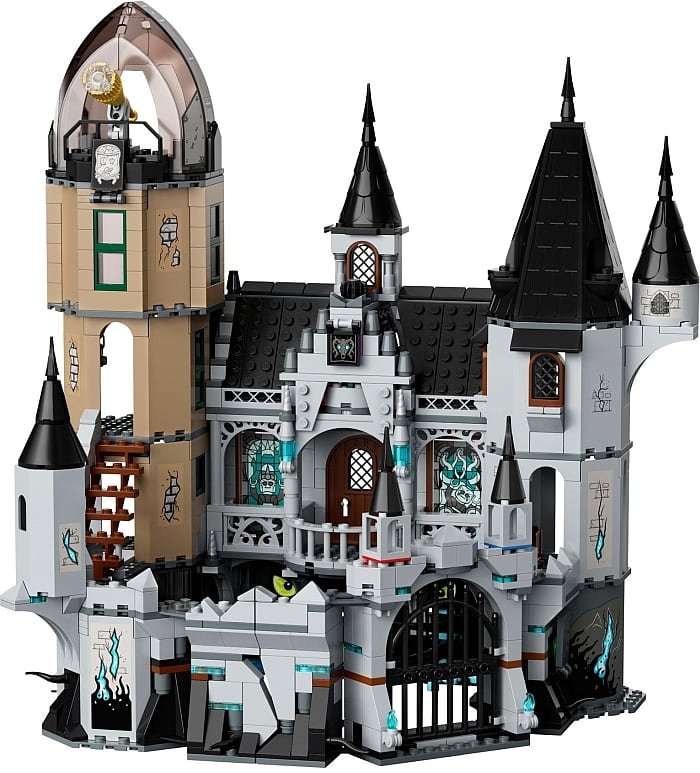
Take, for instance, the black sections used in the Mystery Castle. They are often connected to weird tentacles and teeth. These provide a sense of context for the black. When you see it, you know that the building is being possessed in these areas. Likewise, the translucent blues give us a sense of mystic energies at work. So, wherever we see it we know there’s power involved.
More commonly, color can be a signifier of age. For the most part, the Mystery Castle is built in shades of gray. However, the observatory tower features some dark-tan elements. This gives us an indication that it is possibly a more recent addition to the building.
I have seen a number of custom models built by LEGO fans using a weathered color scheme that look really good. However, if you really want your model to pop, c consider adding some newer construction to give a point of context and contrast.
There’s no right or wrong way to use color in this way. The best advice I can give is to create the story you want to tell in your head. Then use color to help embellish that story to give your model a bit more depth and personality.
LEGO HIDDEN SIDE CASTLE – VIEWING ANGLES
I mentioned before that the Mystery Castle’s surprise can be completely ruined if it is viewed from a particular angle (watch my review video above to see this in action). It’s a rather risky building technique to force particular viewing angles for your creation. Generally, you want to use this when the whole point of your model is to unfold some sort of surprise. It’s odd to say, but what you are really trying to figure out is how to cover up things you only want to be seen at a later point. The problems add up when designing blinds that cover up the surprise. Conceal things too well and you probably risk making it hard to see whatever you do uncover. However, if you don’t add enough blinds then the surprise can be ruined just from looking at the model from the wrong direction.
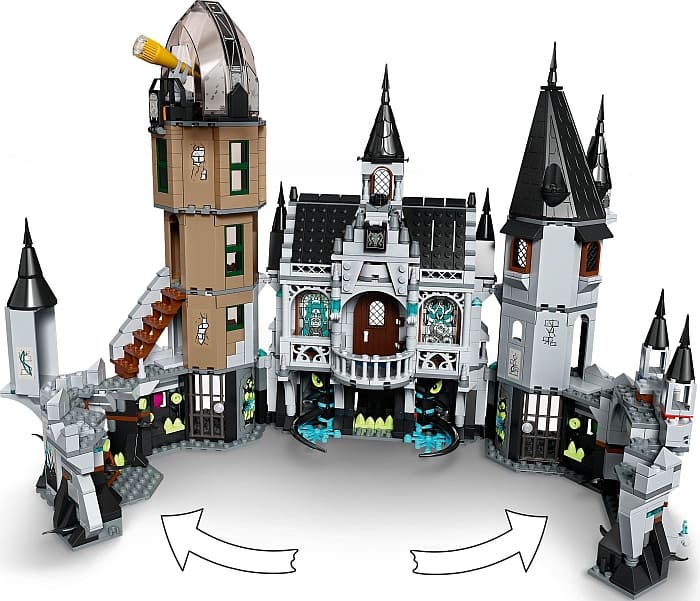
When dealing with these problems, my advice is actually not a building technique. Rather, you will need to solve how to display the model for best viewing effect. This could involve raising the model up, putting partitions in the way to avoid people from seeing it at certain angles, or even control the way the model is lit.
The real technique will come in from how to accommodate these limitations you will need to place on your creation. As mentioned before, the Mystery Castle seems best viewed from the point of view of a minifigure. This puts the walls and towers in all the right spaces to hide the secrets this set holds. Done right, you can have a truly spectacular display. Done wrong, and you’ll have people miss out on the best things.
APPLYING WHAT YOU LEARN
When it comes to moving elements, we can’t just point at one solution and say that’s how to do it. With a creative tool like LEGO bricks, you have nearly countless ways to get something done. And given the fact that LEGO continues to release new interesting parts, that number of options only grow. So, it’s more reasonable to point out useful principles that you might commonly find among similar types of creations.
Personally, I like the concept of building a shared trigger since it is not so daunting. And when done right, it can help accomplish something that is rather challenging. The more practice you have with this technique, the better you can become.
Speaking of becoming better, having a strong sense of narrative in your creation can really make a world of difference. The thing is, you don’t need to have the best building skills. Sometimes all you need is to know how to get out the most from the colors you build with. Making them represent particular items or concepts lends a measure of depth to a design that will make your creations much more captivating.
And finally, capturing your audience is often the goal of LEGO builders. This is why it is important to figure out how your model will be viewed. We sometimes unconsciously focus specifically on certain angles to the exclusion of all else. Take any of the LEGO Modular Buildings as an example. Most of the time, they look like a million bucks from two sides, but they aren’t so impressive from the remaining two angles. If you prepare for this, you can set up your model to be viewed in the best light from the optimum direction. Doing this will in turn give you more building opportunities to consider. Do you hide a special surprise when something moves out of the way? Do you force the viewer to look through a particular portal to limit how they see your creation? Each of these present an interesting way to consider a model as well as giving you more experience at displaying the best parts of your imagination!
I hope you found this review interesting and informative, and that you will try out some of the techniques yourself. If you’re interested in the set, or other sets from the collection, check out the LEGO Hidden Side section of the Online LEGO Shop.


What do you think? Do you have any of the LEGO Hidden Side sets? How do you like them? And what do you think of the transformational features and interesting building techniques we discussed here? Feel free to share your thoughts and discuss in the comment section below!
And you might also like to check out the following related posts:












I have this set and love it. In fact I put it with my Harry Potter theme because it could pass up as maybe the Malfoy’s home. It almost has that dark feel from Harry Potter.🤔
I like that idea! 😀
I guess this is the best we will get as far as a castle, so I got one. Admin wrote about all the rare pieces previously, and I had to go for it.
Not a bad set at all. I might pick it up when it goes on sale. I heard hidden side is getting discontinued, so it shouldn’t be long. The double action feture is probably the most interesting, and I like the parts.
The timing mechanism to activate multiple actions is what caught my attention. It’s something I have tried in the past, but couldn’t work out successfully. It’s obvious when it’s done, but tricky to implement.